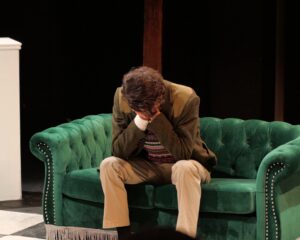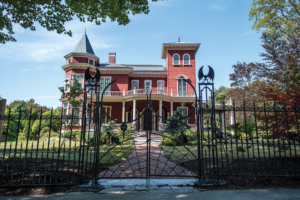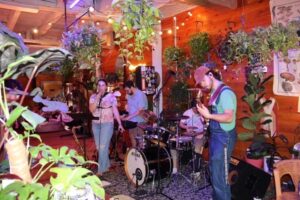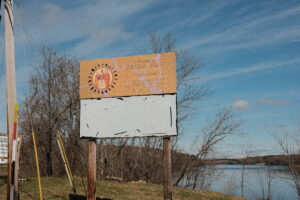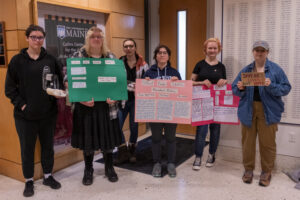This summer, tucked away in a wall of Carnegie Hall at the University of Maine, researchers at the VEMI Lab recovered nine life-sized paintings and a five-panel mural. Dating back to the 1960s, the colorful and abstract paintings depict people, towns and harbors.
Upon entering the old Hollowell granite building of Carnegie Hall, a navy blue wall with large yellow letters reading “VEMI” stands tall. No one would guess that behind the wall of contrasting colors is a hollow storage space sealed shut by three screws. Not even the people at VEMI Lab, who had inhabited the building for almost 10 years, knew until they unscrewed the wall for electrical power this summer. According to Corey, they wanted to mount a TV on the opposite side of the “VEMI” wall, facing the inside of the building.
RJ, the lab manager at VEMI Lab, was the first to peer into the space.
According to Richard Corey, the director of VEMI Lab, the first words that left RJ’s mouth were, “Nope, Rick, this is all you.”
As they began to pull the paintings out of the wall, Corey called George Kinghorn, the Senior Executive Director of Cultural Engagement and Arts Initiatives at the UMaine. Kinghorn oversees the Collins Center for the Arts, the Hudson Museum and the Zillman Art Museum. According to Corey, Kinghorn instructed the folks at VEMI Lab not to touch anything and to wait for them to come by to retrieve the paintings. People from Zillman Art Museum drove over a van and conducted, according to Corey, “the white glove treatment,” and took the artwork away.
Corey said that Sarah Belisle, the registrar at the Zillman Art Museum, found three of the nine paintings in ZAM’s online database. Written as a note for the three paintings was “Carnegie Hall: In a wall.”
The paintings are those of Richard Derby Tucker, a New York-born and Maine-based artist who lived from 1903 to 1979. He was known for his mod still-life paintings and was a founding member of the Maine Coast Artists in Rockport, Maine.
The fact that paintings were found in a wall of Carnegie may seem surprising at first, but given the building’s extensive history, it’s to be expected.
“On occasion, you travel through this place, and you find weird things,” said Corey.
As one of UMaine’s spookiest structures, Carnegie Hall stands out among the abundant brick buildings on campus. The hall was built in 1906 as a gift from the state legislature after they recognized UMaine as a public university. The eponymous Andrew Carnegie donated $50,000 to the Maine State Legislature to construct the new library. Carnegie was an industrialist who, between the years 1893 and 1919, donated $60 million to build 1,689 public libraries in the United States and the United Kingdom.
It was an impressive library, with a glass dome as the ceiling above a flemished oak-finished rotunda. According to the UMaine website, the building had a stack room with iron stacks and glass floors.
It was replaced by the well-known Fogler Library in 1947. The stack room was renovated as the Music and Arts Department moved into the building. In 1967, the rotunda was filled in, the dome was removed, and the oak finish was painted over or removed.
The building still stands out today, but internally, it’s lost much of its original character. At one point, the walls were carpeted to accommodate the art gallery, now known as the Zillman Art Museum, that once inhabited the hall. There are big art sinks around the building, which were put in when the art department used the hall as a studio space. As of this past spring, a custom-built autonomous vehicle simulator sits in the hall. According to Corey, it is used to research human interactions with fully autonomous transportation systems.
The recent discovery of Tucker’s paintings on a wall of Carnegie Hall provides a glimpse into the building’s history. Once a grand library, Carnegie has transformed over the decades into an eclectic home for everything from art studios to autonomous vehicle research. Like the building that housed it, the art has gone on an unexpected journey. Standing out on this campus of bricks, Carnegie Hall remains a monument to the university’s dynamic past, present, and future.


